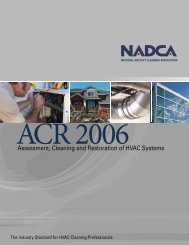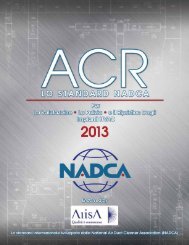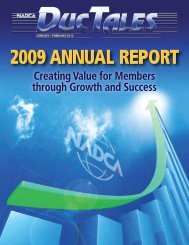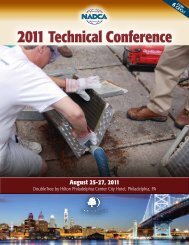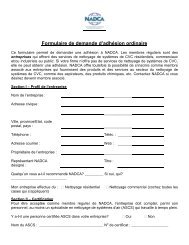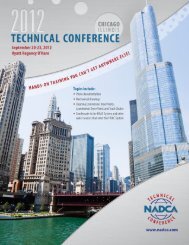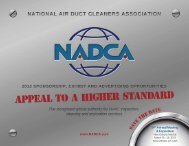Candidates Guide for Certified Ventilation Consultant (CVC) - NADCA
Candidates Guide for Certified Ventilation Consultant (CVC) - NADCA
Candidates Guide for Certified Ventilation Consultant (CVC) - NADCA
You also want an ePaper? Increase the reach of your titles
YUMPU automatically turns print PDFs into web optimized ePapers that Google loves.
<strong>Candidates</strong> <strong>Guide</strong><br />
<strong>for</strong><br />
<strong>Certified</strong> <strong>Ventilation</strong> <strong>Consultant</strong><br />
(<strong>CVC</strong>)<br />
The <strong>Certified</strong> <strong>Ventilation</strong> <strong>Consultant</strong> (<strong>CVC</strong>) is an advanced, comprehensive certification<br />
targeted to highly qualified experts in the field of HVAC inspection, cleaning and<br />
restoration. This credential covers the knowledge, skills and abilities required to inspect,<br />
clean and remediate HVAC systems, combined with 5 years of industry field experience<br />
which include residential, commercial and institutional markets. This certification<br />
requires a working knowledge of HVAC systems, including basic operations and<br />
troubleshooting.<br />
©2011
Introduction<br />
<strong>NADCA</strong>’s ASCS certification was developed to recognize those industry professionals<br />
involved in the proper cleaning of HVAC systems, which has been very successful over<br />
the years. Today, many job specifications require that a certified ASCS be on a project.<br />
While the ASCS certification is both necessary and valid, a need has arisen <strong>for</strong> the<br />
industry to recognize an individual’s scope of work involved in a complete HVAC<br />
inspection, cleaning, and restoration project beyond just the cleaning process.<br />
This advanced certification provides individuals with the opportunity to be recognized <strong>for</strong><br />
their knowledge and skill sets in managing a complete HVAC system cleaning project<br />
from initial scope of work, to project management, and through to completion within all<br />
building classifications. Individuals who hold this designation will be qualified to<br />
manage any type of HVAC cleaning project <strong>for</strong> all building types.<br />
Who Is Eligible?<br />
In order to sit <strong>for</strong> the <strong>CVC</strong> examination, a candidate must first hold the ASCS, CVI and<br />
VSMR certifications. In addition, a candidate must demonstrate the equivalent of 5 years<br />
of industry experience.<br />
Examination Description<br />
The examination consists of 115 multiple choice questions. <strong>Candidates</strong> will have 3 ½<br />
hours to complete the exam. The passing score will be determined after review of<br />
statistical analysis following the first exam administration.<br />
The content of the examination is based on a scientific survey of <strong>NADCA</strong> members,<br />
certificant holders, and industry professionals who engage in the practice of HVAC<br />
system inspection, cleaning and restoration. This survey evaluated the relative<br />
importance of the knowledge and skills that comprise the practice of managing an entire<br />
HVAC system cleaning project <strong>for</strong> all building classifications. The content areas tested,<br />
and their relative emphasis are provided in the examination content outline beginning on<br />
page three of this <strong>Guide</strong>.
Examination Delivery<br />
The <strong>CVC</strong> certification exam will be available at standardized testing centers around the<br />
globe. It will also be administered during <strong>NADCA</strong>’s Annual Meeting and other<br />
scheduled training conferences. All pre-requisites must be met be<strong>for</strong>e an individual can<br />
sit <strong>for</strong> the exam.<br />
Maintaining the Credential<br />
<strong>Candidates</strong> who successfully pass the exam will hold the designation <strong>for</strong> 5 years, and it<br />
will be renewable every 5 years. <strong>Candidates</strong> will renew by obtaining 40 continuing<br />
education credits (CECs) and submitting a renewal fee of $495 member/ $1200 nonmember.<br />
Recommended Reading<br />
This exam places a strong emphasis on field experience and knowledge. While the items<br />
listed below will assist in preparing <strong>for</strong> the <strong>CVC</strong> exam, this is not a comprehensive and<br />
exhaustive list of everything covered in the exam.<br />
In addition to holding ASCS, VSMR and CVI certifications, candidates should review the<br />
following resource materials.<br />
<strong>NADCA</strong> Standards<br />
ASHRAE<br />
Standard 55 (thermal com<strong>for</strong>t)<br />
Standard 62.1 and 62.2 (ventilation air)<br />
Standard 52.2 (air filter standard)<br />
Standard 180 (HVAC inspection and maintenance)<br />
NFPA<br />
Standard 90-A - Standard <strong>for</strong> the Installation of Air-Conditioning and <strong>Ventilation</strong><br />
Systems<br />
Standard 90-B – Standard <strong>for</strong> the Installation of Warm Air Heating and Air-<br />
Conditioning Systems<br />
Standard 96 (<strong>Ventilation</strong> control)<br />
Standard 255 (Surface burning characteristic)<br />
SMACNA<br />
HVAC Duct Construction<br />
Fibrous Glass Duct Construction<br />
NAIMA AH 122<br />
IICRC<br />
S-500 (water restoration)<br />
S-520 (mold remediation)<br />
Air Diffusion Council Flexible Duct Per<strong>for</strong>mance and Installation Standard
Examination Content<br />
The content of the <strong>CVC</strong> certification is organized into four domains:<br />
Domain % of Questions<br />
I. Project Management 14%<br />
II. Health & Safety 15%<br />
III. HVAC Equipment Inspection, Maintenance and Restoration 60%<br />
IV. Standards and <strong>Guide</strong>lines 30%<br />
All exam items are referenced to the exam content outline below.<br />
I. Project Management<br />
A. Project assessment<br />
1. Initial site visit<br />
2. Scope of work<br />
B. Other requirements<br />
1. Understand mechanical drawings and specifications<br />
2. Prepare take-offs<br />
3. Per<strong>for</strong>m quality control audits according to current industry standards<br />
II. Health & Safety<br />
A. Employee safety<br />
Understanding OSHA requirements as they pertain to employee safety<br />
such as PPE, Lockout/tag out, GFCI, confined space, fall protection, etc.<br />
B. Environment safety<br />
Understanding proper environmental safety requirements applied during a<br />
project including but not limited to cross-contamination procedures, fire<br />
safety, engineering controls, project hazards, etc.<br />
C. Occupant safety<br />
D. Containment strategies<br />
E. Understand tool, equipment, and instrumentation use and safety<br />
III. HVAC Equipment Inspection, Maintenance and Restoration<br />
A. Understand HVAC systems<br />
Includes basic HVAC design theory, knowledge of all system<br />
components, system operation and controls, and general industry<br />
knowledge.<br />
B. Understand system components and restoration techniques<br />
To include types of coils, drain lines and pans, fans, types of ductwork,<br />
and all other components found within or part of the HVAC system.<br />
C. Inspection of HVAC systems<br />
Understanding types of equipment used, how to conduct an inspection,<br />
and reporting on the findings.
D. Maintenance (cleaning) of HVAC systems<br />
1. Choosing appropriate cleaning techniques<br />
2. Understanding the use of tools and equipment<br />
3. Per<strong>for</strong>m accessing and closing the system<br />
E. Restoration of HVAC system components<br />
1. Remove fiberglass insulation<br />
2. Re-line or re-insulate system components<br />
3. Refurbish components<br />
F. Products and supplies<br />
1. Provide and follow Material Safety Data Sheet (MSDS)<br />
2. Understand product application/limitation<br />
IV. Standards and <strong>Guide</strong>lines<br />
A. Microbiological remediation guidelines<br />
1. Understand microbiological agents and concepts<br />
2. Understand factors associated with microbiological growth<br />
3. Establish remediation plan<br />
4. Understand factors contributing to microbiological development<br />
5. Work with professionals in contamination assessment, remediation and<br />
restoration<br />
B. Standards<br />
1. <strong>NADCA</strong><br />
2. ASHRAE<br />
3. NFPA<br />
4. SMACNA<br />
5. NAIMA AH 122<br />
6. IICRC<br />
7. Air Diffusion Council Flexible Duct Per<strong>for</strong>mance and Installation<br />
Standard<br />
8. Understand regulatory agencies having jurisdiction<br />
9. Understand other applicable industry standards<br />
C. <strong>Guide</strong>lines<br />
1. <strong>NADCA</strong> <strong>Guide</strong>lines<br />
2. NYC DOH <strong>Guide</strong>lines<br />
3. NAIMA HVAC Fibrous Glass Duct Construction <strong>Guide</strong>lines<br />
4. NAFA <strong>Guide</strong> to Air Filtration<br />
5. Other Applicable <strong>Guide</strong>lines



